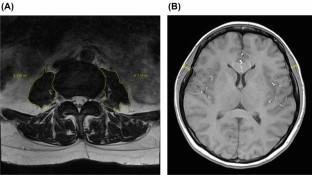Journal of Neuro-Oncology ( IF 3.9 ) Pub Date : 2024-03-02 , DOI: 10.1007/s11060-023-04542-w Mervyn Jun Rui Lim , Zheting Zhang , Yilong Zheng , Ivan Wei Loon Khoo , Rhianne Caitlin Vaz Xin Ying , Sophie Jia Qian Koh , Ethanyn Lim , Pei Ing Ngam , Betsy Soon , Ying Liang Low , Li Feng Tan , Kejia Teo , Vincent Diong Weng Nga , Tseng Tsai Yeo

|
Purpose
Sarcopenia and frailty have been associated with increased mortality and duration of hospitalization in cancer. However, data investigating these effects in patients with brain metastases remain limited. This study aimed to investigate the effects of sarcopenia and frailty on clinical outcomes in patients with surgically treated brain metastases.
Methods
Patients who underwent surgical resection of brain metastases from 2011 to 2019 were included. Psoas cross-sectional area and temporalis thickness were measured by two independent radiologists (Cronbach’s alpha > 0.98). Frailty was assessed using the Clinical Frailty Scale (CFS) pre-operatively and post-operatively. Overall mortality, recurrence, and duration of hospitalization were collected. Cox regression was performed for mortality and recurrence, and multiple linear regression for duration of hospitalization.
Results
145 patients were included, with median age 60.0 years and 52.4% female. Psoas cross-sectional area was an independent risk factor for overall mortality (HR = 2.68, 95% CI 1.64–4.38, p < 0.001) and recurrence (HR = 2.31, 95% CI 1.14–4.65, p = 0.020), while post-operative CFS was an independent risk factor for overall mortality (HR = 1.88, 95% CI 1.14–3.09, p = 0.013). Post-operative CFS (β = 15.69, 95% CI 7.67–23.72, p < 0.001) and increase in CFS (β = 11.71, 95% CI 3.91–19.51, p = 0.004) were independently associated with increased duration of hospitalization.
Conclusion
In patients with surgically treated brain metastases, psoas cross-sectional area was an independent risk factor for mortality and recurrence, while post-operative CFS was an independent risk factor for mortality. Post-operative frailty and increase in CFS significantly increased duration of hospitalization. Measurement of psoas cross-sectional area and CFS may aid in risk stratification of surgical candidates for brain metastases.
中文翻译:

肌肉减少症和虚弱对脑转移患者预后的影响
目的
肌肉减少症和虚弱与癌症死亡率和住院时间的增加有关。然而,研究脑转移患者这些影响的数据仍然有限。本研究旨在调查肌肉减少症和虚弱对接受手术治疗的脑转移患者临床结果的影响。
方法
纳入2011年至2019年接受脑转移手术切除的患者。腰肌横截面积和颞肌厚度由两名独立放射科医生测量(Cronbach's alpha > 0.98)。术前和术后使用临床衰弱量表(CFS)评估衰弱程度。收集总体死亡率、复发率和住院时间。对死亡率和复发进行 Cox 回归,对住院时间进行多元线性回归。
结果
纳入 145 名患者,中位年龄 60.0 岁,其中 52.4% 为女性。腰大肌横截面积是总体死亡率(HR = 2.68,95% CI 1.64–4.38,p < 0.001)和复发(HR = 2.31,95% CI 1.14–4.65,p = 0.020)的独立危险因素。 -手术CFS是总体死亡率的独立危险因素(HR = 1.88,95% CI 1.14–3.09,p = 0.013)。术后 CFS(β = 15.69,95% CI 7.67–23.72,p < 0.001)和 CFS 增加(β = 11.71,95% CI 3.91–19.51,p = 0.004)与住院时间延长独立相关。
结论
在接受手术治疗的脑转移患者中,腰大肌横截面积是死亡和复发的独立危险因素,而术后CFS是死亡的独立危险因素。术后虚弱和 CFS 增加显着增加了住院时间。腰肌横截面积和 CFS 的测量可能有助于脑转移手术候选人的风险分层。



























 京公网安备 11010802027423号
京公网安备 11010802027423号